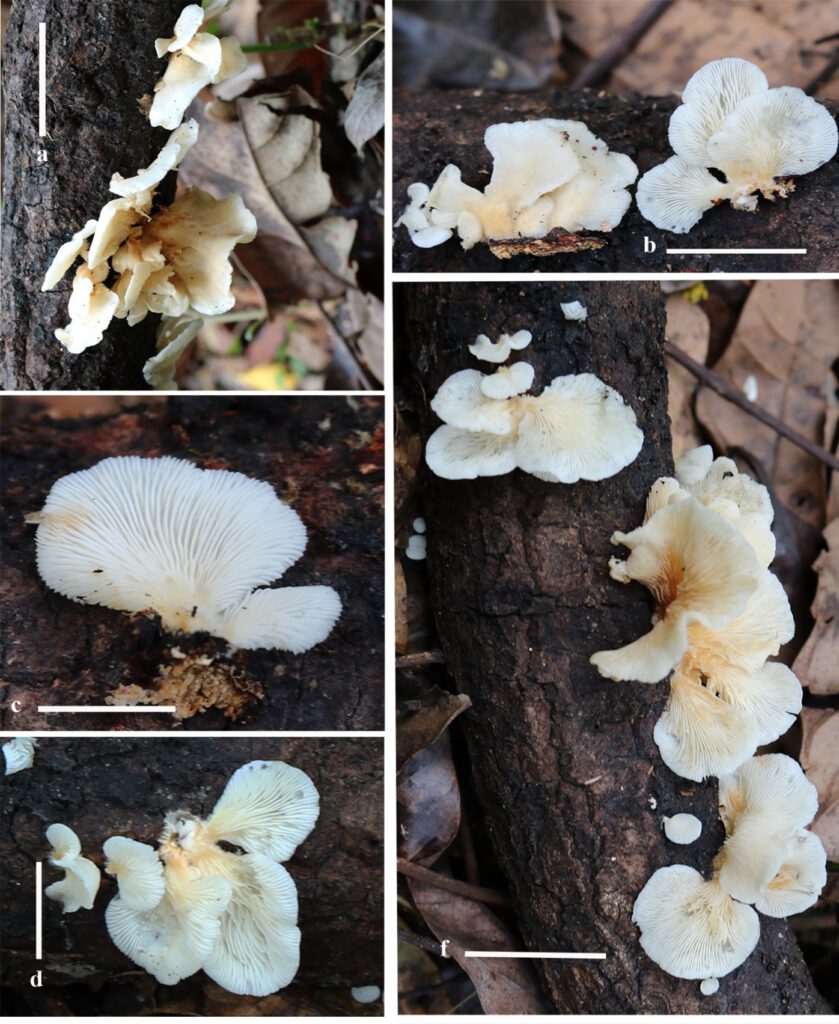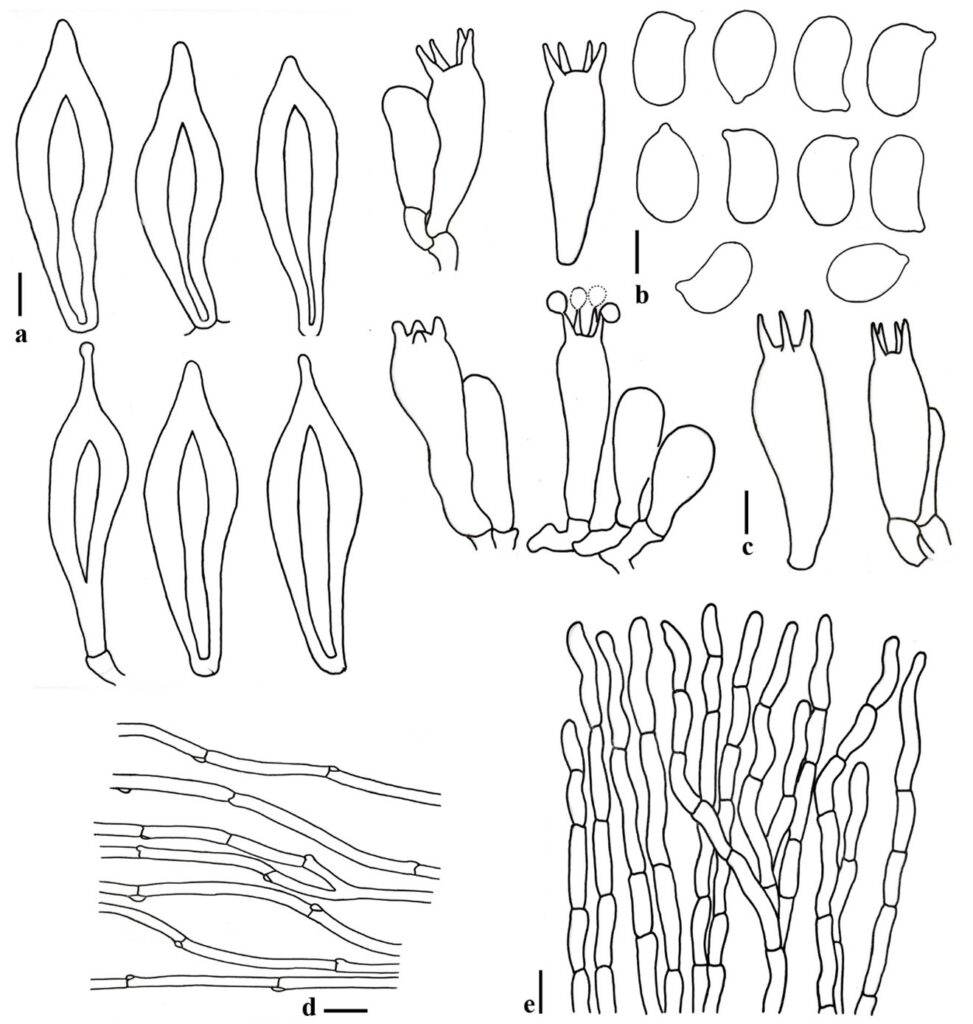Hohenbuehelia flabelliformis sp. nov, Phonemany, Raspé, Thongkl, & K.D Hyde. Figure 2–3
MycoBank number: MB; Index Fungorum number: IF; Faceoffungi number: FoF 10708;
Etymology: Flabelliformis (Latin) is referred to its flabelliform shape of basidiomata.
Holotype: MRC10, MFUL XXX.
Diagnosis: This species is distinguished from others with large flabelliform basidiomata, yellowish-white pileus covers with dense white villose hairs longer at the base and shorter toward the margin, ellipsoid basidiosproses, cheilocystidia absent, and pilieipellis intricate trichoderm, and the diagnostic ITS, LSU, and TEF1 sequence data are supported to new species.
Pileus 35–45 × 20–40 mm diam., spathulate when young, expanding to spathuliform, flabelliform, rounded flabelliform, orbicular; white when young, becoming pale yellow to yellowish white (4A3-4A2) at the center then becoming cream (2A3-2B3) to darker with age; margin white, cover with dense white villose hairs longer at the base, shorter toward margin observed under the lens, the margin rolled to incaved when young, becoming straight, entire or some wavy. Lamellae 1–3 mm wide, decurrent from point of attachment, moderate crowded in mature, with 4–5 lamellulae lengths, edge even concolorous to sides, fimbriate, pale yellow to yellowish white (4A3-4A2) towards margin. Stipe some absent, some have psuedostipe 5–12 mm × 3–8 mm. Context white to dirty white (4A2-4A1), thin, 1 mm wide, soft rather tough, with very thin gelatinous zone. Odor mild to pleasant. Test tasteless. Spore print white.
Basidiospores [150,3,3] (5.8–)6–7–8(–8.6) × (3.5–)3.6–4.2–5(–5.1) µm, Q = (1.3–)1.36–1.67–2.01(–2.03), ellipsoid to elongate (oblong) side-view, smooth, inamyloid, thin-walled. Basidia (20.9–)20.9–25.8–34.6(–36.7) × (5–)5.3–7.3–10.6(–11.3) µm, subclavate to clavate, with 4 sterigmata 4–8 µm long, 2–4 spores, hyaline, smooth, thin-walled. Cheilocystidia absent. Pleurocystidia metuloidal, (28.4–)30.1–41.8–54.2(–55.3) × (8.6–)8.6–10.9–14.4(–14.5) µm, present at both side of lamellae observed under lens, scattered, narrowly fusiform, fusiform, with mucronate at apex, crystal in KOH 5%, with thick walled. Context gelatinous zone thick as revived in 5 % KOH, compound hyphae 2.2–5.4 µm. Hymenophoral trama 2–5 µm, irregular complex. Pileoleptocystidia absent. Pilieipellis intricate trichoderm, hyaline in KOH, brownish in water with cylindrical terminal elements 3.7–7.0 × 34.5–85.7 µm. Clamp connections present in all observed tissues.
Habitat and distribution: Saprobic on dead decay wood, growing in small groups of 2–4 basidiomata. So far only found in Thailand.
Specimens examined: THAILAND, Chiang Mai province, Mae Taeng District, 27th May 2019, Monthien phonemany (MRC-M010, MFUL xxx). Chiang Rai province, Pa Dead District, 9 August 2019, Monthien Phonemany (MT169, MFUL xxx).
Notes: Hohenbuehelia flabelliformis has similar basidiomata color with H. atrocoerulea (Fr.) Singer, H. angustata (Berk.) Singer, H. bonii A.M. Ainsw., H. concentrica Corner, H. carlothornii Consiglio, Setti & Thorn, H. horrida (Boedijn) Corner, H. luteola G. Stev, H. odorata C.K. Pradeep & Bijeesh, and H. testudo (Berk.) Pegler. The basidiomes range from being yellowish-white, yellow-brown, white to pinkish-orange, and spathulate to flabelliform basidiomata. Hohenbuehelia flabelliformis was compared to other Hohenbuehelia species with closed morphological characters. H. angustata (Berk.) originally described from Brazil differed from H. flabelliformis by its smaller basidiomata, smooth, greyish yellow, with stipe 4.5 mm and smaller basidiospores (3.5–5 × 2.5–3.5 µm), and smaller cheilocystidia and pileocystidia (Silva-Filho & Cortez 2017). Our species similar with the morphology of Hohenbuehelia horrida and H. odorata; with both of them having white to yellowish spathulate flabelliform basidiomata, but differ by smaller basidiomata, smaller basidiospores (5–6 × 3–4 µm), lack of cheilocystidia and pileocystidia (Bijeesh et al. 2019). Hohenbuehelia atrocoerulea is greyish yellow, lamellae concolor with sides, white, surface smooth stipe 4.5 mm diam and lecythiform cheilocystidia (15–29 × 2–7.5 µm) (Consiglio et al. 2018), this species is close to H. testudo (Berk.) Pegler but both have different basidiospores size, and metuloid pigment (Baillière 1847). Hohenbuehelia malesiana was described from Brazil different from our species by having large subcylindric basidiospores (7–9 × 3.5–4 µm) and pileipellis an interrupted cutis without metuloidal cystidia. Hohenbuehelia bonii A.M. Ainsw from England, has large yellow-brown basidiomata and smooth with stripe concolorous with lamellae 15 × 20 mm, large basidiospore (7.2–10.4 × (3.6) 4.5–6.1 µm) and an ixotrichoderm of pileipellis (Ainsworth et al. 2016). Hohenbuehelia carlothornii described from Costa Rica, appeared moist, shiny, off-white, pseudostipe (20–32 × 14–25 mm), with present cheilocystidia and lacking pileocystidia (Consiglio et al. 2018). Hohenbuehelia concentrica from Singapore, has larger basidiospores (8–8.5 × 6–6.7 μm), cutis of pileipellis and also without pileocystidia (Corner 1994). Hohenbuehelia incarnata from Solomon Islands, differed from our species by subglobose basidiospores, and cheilocystidia present subcylindric to submoniliform. Hohenbuehelia olivacea Yu Liu & T. originally from China has smaller basidimata, reniform, with dense long tomentum, thicker gelatinous zone, and present cheilocystidia (Liu & Bau 2009). When compared to all the above-mentioned species, Hohenbuehelia flabelliformis is obviously different with large basidiomes white covered with dense white villose hairs yellowish-white, lamellae concolorous to sides, pale yellow to yellowish, pseudostipe 5–12 mm × 3–8 mm is present when young, absent of cheilocystidia.
There is difference of 0.96% in the ITS sequence, 0.88% in the LSU sequence, 0.92% in TEF1 sequence between H. flabelliformis and H. algonquinensis. Furthermore, the phylogenic placement of H. flabelliformis showed it was closely related to H. algonquinensis Consiglio, Setti & Thorn. However, the morphologies of both species are totally different whereby H. algonquinensis has glossy and nearly black to watery basidiomes and cheilocystidia is present (Consiglio et al. 2018) as compared to H. flabelliformis.

Fig. 2: Basidiomes of Hohenbuehelia flabelliformis in the field (a= MT164 (MFUL xxx); b,c,d,e,f=MRC-M010 (MFUL xxx); scale bar a=3 cm, b=4 cm, d=3 cm and e=4).

Fig. 3: Micro-morphological of Hohenbuehelia flabelliformis a= Pleurocystidia, b= Basidiospores, c= Basidia, d= Context hyphae, e = Intricate trichoderm of pilieipellis.
